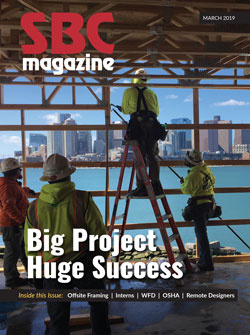President's Message: Breaking Through the Wall
President's Message: Breaking Through the Wall
One of the primary missions of SBCA is to help component manufacturers (CMs) gain greater market share. Traditionally, those efforts have been aimed at turning roof rafters into roof trusses, and that focus has paid significant dividends. In the latest survey of residential builders, wood roof trusses account for 71 percent of the roofs framed (on a square foot basis). If you take the state of Texas out of that equation, where a lot of the nation’s homes are built, and stick-framing is still the primary framing method (57 percent), market share jumps to almost 82 percent.
In contrast, wall panels account for only 14.4 percent of the external walls framed in residential construction (on a lineal foot basis). There is significant market share growth potential for wall panel manufacturers across the country, and the demand is real.
Another builder survey conducted in December indicates that in 2019, 27 percent of builders plan to increase their use of open wall panels (where the wall panel is sheathed on a maximum of one side). Thirty-four percent plan to increase their use over the next five years. The percentages are similar for closed wall panels (panels where both exterior and interior sheathing is applied by the manufacturer) – 22 percent plan to increase their use in 2019, and 29 percent plan to over the next five years.
Those builder responses paint a clear picture: The market share of wall panels is likely to change dramatically over the next five years. This makes sense in that traditionally, when field labor is abundant, the use of panels declines. When there is a shortage of labor, the demand for wall panels increases.
We could simply be entering into that part of the housing cycle again, but this time feels different for a few reasons. One, the labor shortage appears to be more of a long-term problem than the construction industry has faced in the past. Two, with the building code requiring a more energy efficient building envelope, more is being asked of the wall system. Three, with advancements in building material technology, which ties in with the previous point, manufacturing a wall panel with more value-added products in it makes sense.
This means we can’t keep doing what we’ve always done. One of the largest obstacles to wall panel use occurs when framers don’t provide framing cost accommodations to their customers for panelization. So we have to become better as an industry at getting the framer invested in this approach to wall framing.
It seems obvious to start with the many benefits wall panels offer to the framer and the general contractor (GC). In the 2015 Framing the American Dream (FAD) study, it took stick-framers five times longer to build the walls on site than it did for installers to erect the wall panels. The National Framers Council (NFC) and SBCA also held a wall panel framing demonstration on the show floor at BCMC 2017. Through that demonstration, it was clear that wall panels offer additional benefits beyond faster cycle times, including minimizing jobsite variables and better coordination with the GC due to wall panels being designed ahead of time.
I’d encourage you to look through the FAD data yourself. Check out the articles on wall panels that have been published in SBC Magazine over the past year, and visit bestwaytoframe.com for ideas and approaches for adding or enhancing wall panels as a product offering. Again, the demand is real and an additional opportunity for all CMs to expand their sales.

